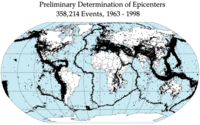
Photo from wikipedia
Abstract One of the most common approaches to assess the collapse capacity of structures under earthquakes is incremental dynamic analysis (IDA), which tracks relationship between a structural damage measure and… Click to show full abstract
Abstract One of the most common approaches to assess the collapse capacity of structures under earthquakes is incremental dynamic analysis (IDA), which tracks relationship between a structural damage measure and a ground motion intensity measure by so-called IDA curves. This IDA approach often uses collapse criteria given in terms of a large value of the maximum inter-story drift ratio, plastic hinge formations at structural components, or flattening of the IDA curve. However, these collapse criteria may not accurately represent the overall collapse behavior of structural systems due to redistribution and variation of damage within the structure. Moreover, collapse predictions by these subjective collapse limit-states are found to be sensitive to the assumed threshold values and to the characteristics of IDA curves. For more accurate assessment of collapse capacity and the likelihood of the collapse, this paper proposes a new collapse criterion that describes dynamic instability of frame structures in terms of the balance between the energies from the applied gravity loads and input ground motions. The collapse criterion is developed for planar frames under horizontally applied earthquakes and then tested using computational models of collapse behavior of ductile steel frame structures, which are validated by experiments reported in the literature. The collapse prediction results by the developed collapse criterion and existing criteria are compared in order to investigate sensitivity of the prediction results with respect to threshold values used by existing approaches. The results show that the proposed energy-based seismic collapse criterion is a more reliable option for assessing structural collapse of planar frames. The energy-based criterion can represent global dynamic instability of structural system more effectively by using aggregated quantities of energy responses of structural components instead of using assumed threshold values for structural responses such as story drifts.
Journal Title: Engineering Structures
Year Published: 2017
Link to full text (if available)
Share on Social Media: Sign Up to like & get
recommendations!